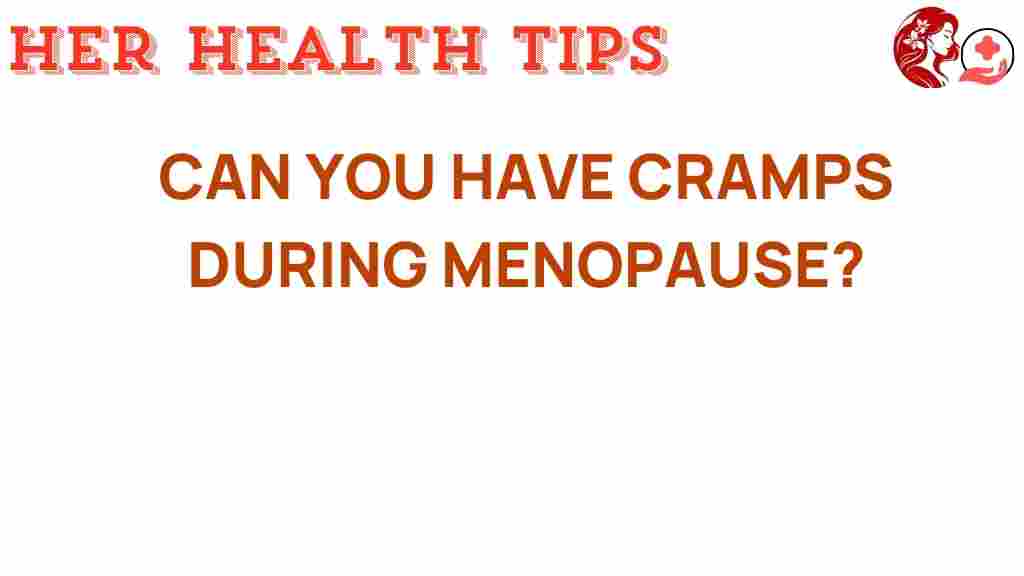Unraveling the Mystery: Can You Experience Cramps During Menopause?
Menopause is a natural phase in a woman’s life that marks the end of her reproductive years. This transition is often accompanied by various symptoms due to significant hormonal changes in the body. Among these symptoms, many women report experiencing cramps, which can lead to confusion and discomfort. In this article, we will explore the relationship between menopause and cramps, shedding light on how hormonal shifts impact women’s health during this stage of aging. We will also provide helpful tips to manage these symptoms and promote overall wellness.
Understanding Menopause and Its Symptoms
Menopause typically occurs between the ages of 45 and 55, although it can happen earlier or later for some women. During this time, the ovaries gradually produce less estrogen and progesterone, leading to the cessation of menstrual cycles. This hormonal change can result in a variety of symptoms, including:
- Hot flashes
- Night sweats
- Sleep disturbances
- Mood swings
- Cramps
- Vaginal dryness
- Weight gain
Among these symptoms, cramps can be particularly perplexing as many women associate cramps with their menstrual cycles, which cease during menopause. However, the body’s adjustment to lower hormone levels can still cause discomfort.
The Role of Hormonal Changes in Cramps
During menopause, hormonal fluctuations can lead to various physical changes in the body. While most women expect their menstrual cycles to stop, hormonal changes can still trigger sensations similar to menstrual cramps. Here’s how these hormonal shifts can affect women:
- Estrogen Levels: Lower estrogen levels can lead to changes in the uterus and pelvic area, causing muscle spasms and discomfort.
- Prostaglandins: These hormone-like substances may still be present and can lead to cramping sensations even after the menstrual cycle has ended.
- Stress and Anxiety: Menopause can be a stressful time, and stress can exacerbate physical symptoms, including cramps.
Why Do Some Women Experience Cramps During Menopause?
Understanding why some women experience cramps during menopause involves recognizing how the body adapts to hormonal changes. Here are some reasons why cramps may occur:
- Perimenopause: This is the transitional phase leading up to menopause, during which hormonal fluctuations are more pronounced and can cause cramping.
- Muscle Tension: Changes in hormone levels can lead to muscle stiffness and tension, resulting in cramping sensations.
- Underlying Health Conditions: Conditions such as fibroids, endometriosis, or pelvic inflammatory disease can still cause cramps during menopause.
Identifying Cramps vs. Other Discomforts
It’s crucial to differentiate between cramps related to menopause and other potential sources of discomfort. Here are some signs to help you identify the nature of your cramps:
- Location: Menopausal cramps often occur in the lower abdomen or pelvis.
- Duration: These cramps may be intermittent and not as prolonged as menstrual cramps.
- Associated Symptoms: If cramps are accompanied by heavy bleeding or severe pain, it may indicate an underlying condition that requires medical attention.
Managing Cramps and Discomfort During Menopause
While cramps can be uncomfortable, there are several strategies you can employ to manage your symptoms effectively:
Step-by-Step Process for Relief
Follow this step-by-step process to help alleviate cramps during menopause:
- Stay Hydrated: Drink plenty of water to help reduce muscle tension and alleviate cramps.
- Heat Therapy: Apply a heating pad to the lower abdomen to soothe cramps and relax muscles.
- Gentle Exercise: Engage in light physical activity, such as walking or yoga, to improve circulation and reduce discomfort.
- Mindfulness and Relaxation: Practice relaxation techniques, such as meditation or deep breathing, to manage stress and tension.
- Consult Your Doctor: If cramps persist or worsen, speak with your healthcare provider to rule out any underlying conditions.
Additional Tips for Women’s Health and Wellness
In addition to managing cramps, focusing on overall wellness during menopause is essential. Here are some tips to consider:
- Balanced Diet: Maintain a healthy diet rich in fruits, vegetables, whole grains, and lean proteins to support hormonal balance.
- Regular Exercise: Incorporate regular physical activity into your routine to help manage weight and improve mood.
- Regular Check-Ups: Schedule regular appointments with your healthcare provider to monitor your health during this transition.
- Support Groups: Consider joining a support group for women experiencing menopause to share experiences and coping strategies.
When to Seek Medical Attention
While cramps can be a common symptom during menopause, certain situations warrant immediate medical attention. Contact your healthcare provider if you experience:
- Severe or persistent cramps that do not improve with home care.
- Heavy bleeding or passing of large blood clots.
- Symptoms of infection, such as fever or unusual discharge.
- Severe pelvic pain that may indicate an underlying condition.
Understanding the complexities of menopause and its symptoms, including cramps, is vital for women’s health. By recognizing the causes and employing effective management strategies, women can navigate this transition with more confidence and less discomfort.
Conclusion
In conclusion, experiencing cramps during menopause is not uncommon, and it often relates to the hormonal changes that occur as women age. By understanding the causes of these cramps and implementing strategies for relief, women can enhance their wellness and quality of life during this significant transition. Always remember to consult with a healthcare provider when it comes to your health concerns, especially if symptoms become severe or persistent.
For more information on managing menopause symptoms, consider visiting this resource for expert advice and support. Remember, you are not alone in this journey, and there are many avenues for support and relief.
This article is in the category Reproductive and created by HerHealthTips Team
